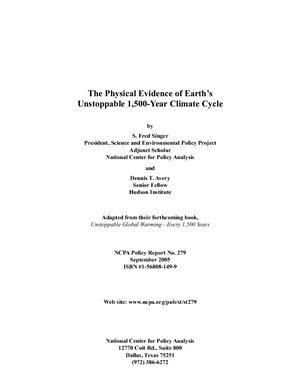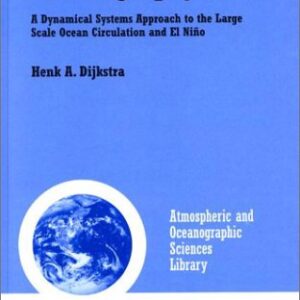NCPA ([US] National Center for Policy Analysis) Policy Report No.
279. September 2005, ISBN #1-56808-149-9, 29 pages.
Executive Summary
The Earth currently is experiencing a warming trend, but there is scientific evidence that human activities have little to do with it. Instead, the warming seems to be part of a 1,500-year cycle (plus or minus 500 years) of moderate temperature swings. It has long been accepted that the Earth has experienced climate cycles, most notably the 90,000-year Ice Age cycles. But in the past 20 years or so, modern science has discovered evidence that within those broad Ice Age cycles, the Earth also experiences 1,500-year warming-cooling cycles. The Earth has been in the Modern Warming portion of the current cycle since about 1850, following a Little Ice Age from about 1300 to 1850. It appears likely that warming will continue for some time into the future, perhaps 200 years or more, regardless of human activity.
Evidence of the global nature of the 1,500-year climate cycles includes very long-term proxies for temperature change ? ice cores, seabed and lake sediments, and fossils of pollen grains and tiny sea creatures. There are also shorter-term proxies ? cave stalagmites, tree rings from trees both living and buried, boreholes and a wide variety of other temperature proxies. Scientists got the first unequivocal evidence of a continuing moderate natural climate cycle in the 1980s, when Willi Dansgaard of Denmark and Hans Oeschger of Switzerland first saw two mile-long ice cores from Greenland representing 250,000 years of Earth?s frozen, layered climate history. From their initial examination, Dansgaard and Oeschger estimated the smaller temperature cycles at 2,550 years. Subsequent research shortened the estimated length of the cycles to 1,500 years (plus or minus 500 years).
Other substantiating findings followed:
An ice core from the Antarctic?s Vostok Glacier ? at the other end of the world from Greenland ? showed the same 1,500-year cycle through its 400,000-year length.
The ice-core findings correlated with known glacier advances and retreats in northern Europe.
Independent data in a seabed sediment core from the Atlantic Ocean west of Ireland, reported in 1997, showed nine of the 1,500-year cycles in the last 12,000 years.
Other seabed sediment cores of varying ages near Iceland, in the Norwegian and Baltic seas, off Alaska, in the eastern Mediterranean, in the Arabian Sea, near the Philippines and off the northern tip of the Antarctic Peninsula all also showed evidence of the 1,500-year cycles. So did lake sediment cores from Switzerland, Alaska, various parts of Africa and Argentina, as did cave stalagmites in Europe, Asia and Africa, and fossilized pollen, boreholes, tree rings and mountain tree lines. None of these pieces of evidence would be convincing in and of themselves. However, to dismiss the evidence of the 1,500-year climate cycle, it is necessary to dismiss not only the known human histories from the past 2,000 years but also an enormous range and variety of physical evidence found by a huge body of serious researchers.
Physical
{pdf} The Physical Evidence of Earth?s Unstoppable 1500-Year Climate Cycl Singer S. Fred, Avery Dennis T.
$19.99






Reviews
There are no reviews yet.